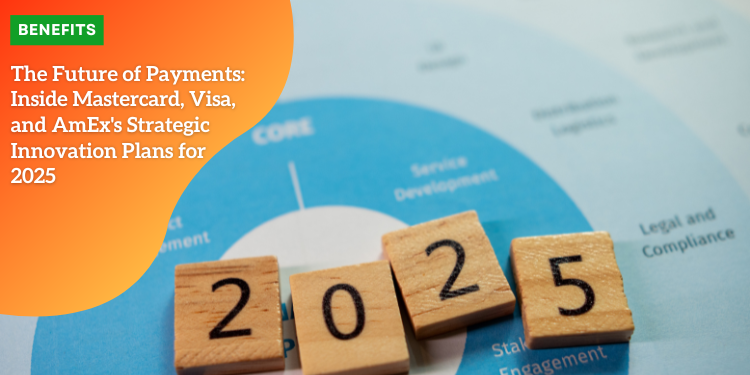The Future of Payments: Inside Mastercard, Visa, and AmEx’s Strategic Innovation Plans for 2025

The Payments Landscape in 2025: Traditional Giants Facing New Challenges
The Shifting Payments Environment
As digital wallets and big tech payment options multiply, it might seem like the classic U.S. card giants could get left behind.
Instead, Mastercard, Visa, American Express, and Discover are keeping their edge.
Mastercard and Visa work behind the scenes, letting banks offer their payment tech to customers.
American Express and Discover, by contrast, wear two hats: they issue cards directly and own the networks merchants use to accept payment.
This dual role gives AmEx and Discover unique control over their customer experience—a real advantage as competition heats up.
Staying Ahead in a Crowded Market
Innovation is the name of the game.
Mastercard and Visa are moving way beyond plastic cards.
They’re teaming up with fintechs and digital banks to launch new services.
Both are all in on “value-added services” like fraud prevention, consulting, and authentication—often through buying up inventive fintechs to boost their own offerings.
These moves help them stay relevant as new technologies reshape how consumers pay.
Tap-to-pay, in particular, is catching on fast in transit, and both firms see it as a way to drive even more volume at coffee shops and stores that follow transit purchases.
Market Dynamics and Big Moves
American Express continues to adapt its strategies in step with industry changes.
But the most eye-catching shift? Discover’s pending acquisition by Capital One.
With Capital One gaining access to Discover’s networks, the industry could see new competitive wrinkles, giving one bank both card-issuing and payment infrastructure strength.
Looking forward, the ground remains fertile for new players, but these classic companies show they’re not just survivors—they’re modernizing forces in payments.

Beyond Plastic: How Mastercard and Visa Are Reinventing Their Business Models
Shifting from Plastic to Digital Powerhouses
Mastercard and Visa have come a long way from their days as simple providers of “plastic” credit cards for banks.
Today, they’re not just card networks—they’re end-to-end payment solutions providers moving quickly to adapt to a fast-changing financial environment.
Instead of focusing only on traditional banks, these giants are expanding their reach by forging partnerships with fintech startups, digital-first banks, and even companies outside the usual financial sector.
This broader approach lets them stay relevant as new players and technologies challenge the old ways of paying for things.
Strength in Partnerships and Acquisitions
One of the smartest moves by Mastercard and Visa in recent years has been to partner with innovators—think fintechs, challenger banks, and digital wallets.
These partnerships help them offer more than just card transactions.
They gain access to new customer segments, fresh ideas, and advanced technology.
In many cases, Mastercard and Visa have also acquired smaller companies to bring value-added services under their roof, covering everything from fraud protection and marketing to consulting and data analytics.
Value-Added Services Drive Growth
Value-added services have become a game changer for both networks.
These services—consulting, marketing, security, fraud prevention, and identity solutions—are essential in a digital world that’s more open but also more complex.
By helping banks, merchants, and even governments manage payments securely and effectively, Mastercard and Visa ensure they’re not just processing transactions, but actively building trust and innovation in the ecosystem.
This strategy gives them a strong competitive advantage as payments move well beyond plastic cards.
With digital transformation unfolding rapidly, there’s more to explore about how payment networks integrate value-added services with their core business to shape commerce’s future.
Mastercard’s Innovation Strategy: Value-Added Services and Transit Solutions
Integrating Value-Added Services with Core Transactions
Mastercard no longer sees value-added services as a side business.
Instead, these services work hand-in-hand with every payment processed on its network.
By embedding consulting, marketing, fraud detection, and authentication into daily transactions, Mastercard can deepen its ties with banking partners and open access to new customer “wallets.”
These collaborations aren’t limited to traditional banks—partnerships with fintechs and digital challenger banks play a vital role.
Mastercard’s approach is about solving modern payment pain points directly within its ecosystem, bolstering convenience, safety, and customer loyalty.
The Power of Tap-to-Pay in Transit
Mastercard’s push into public transit is a prime example of innovation translating into real business gains.
The company’s tap-to-pay technology lets commuters quickly access buses and trains.
This seamless experience, often with just a smartphone or wearable, sparks what Mastercard calls the “halo effect.”
When consumers get comfortable tapping their phones to ride the subway, they are more likely to use the same device for everyday purchases—like grabbing coffee after their commute.
This added familiarity drives higher transaction volumes across all types of merchants, turning transit payments into a growth engine.
Data Insights and the Future
As payments become more digital, CEO Michael Miebach sees enormous upside in data insights.
The more transactions run through Mastercard, the richer the company’s view of spending trends and risks becomes.
Miebach believes that, as the world digitizes further, helping businesses make sense of these data flows will be a vital revenue stream.
It’s not just about processing payments—Mastercard aims to be a key player in the new world of digital identity and trust, making every transaction safer and smarter.
Mastercard’s blend of value-added services, seamless transit payments, and actionable data insights sets the stage for the evolution of how everyday transactions feel for consumers and merchants alike.
Visa’s Flexible Credential: The Swiss Army Knife of Payments
Reimagining the Payment Card for 2025
Visa’s Flexible Credential is turning heads in the payments industry, and for good reason.
Often described as the “Swiss Army Knife of payments,” this card is designed to do it all.
Rather than juggling multiple cards for different funding sources, users can now toggle between credit, debit, prepaid, commercial accounts, and even rewards points—all through one single card.
Visa CFO Christopher Suh summed it up well at an investor event, saying, “We like to call it the Swiss Army Knife of payments because it’s a single card that enables consumers to toggle between multiple funding sources—credit, debit, prepaid, commercial, and even rewards points” .
Empowering Consumer Choice in a Seamless Experience
What sets this credential apart is its versatility.
Imagine paying for groceries with your debit account, switching to rewards points for your morning coffee, and using a corporate card for business lunch—all with the same card in your digital wallet.
This one-card-to-rule-them-all model puts the consumer firmly in control, making payments more flexible and tailored to modern lifestyles.
Strategic Edge in a Disrupted Market
Visa’s move is a clever response to both fintech disruption and the rise of big tech competitors.
Flexible Credential simplifies life for consumers who want convenience but don’t want to sacrifice security or rewards.
By offering this all-in-one capability, Visa strengthens its position in a fast-changing payments landscape, making it easier for users to stay loyal to the Visa network as new payment options emerge.
Visa’s innovation is sharpening their competitive edge, setting the stage for more seamless payment experiences that meet users wherever they are.
Building Trust in Alternative Payment Channels
The Enduring Appeal of Card Payments
Even as a wave of new payment options, like peer-to-peer apps and digital wallets, rises, traditional card payments remain deeply embedded in consumer habits.
One major reason for this “stickiness” is protection—cards offer users powerful safeguards against fraud, digital identity theft, and unauthorized transactions.
In regions where cards compete fairly with other payment methods, they consistently win trust among consumers and businesses due to these security benefits.
Mastercard’s Focus on Confidence and Safety
Recognizing how crucial trust is, Mastercard is steering its value-added services toward non-card channels.
The company is leveraging its experience with fraud prevention and authentication to inspire confidence no matter how people choose to pay.
This means extending tools and services—like transaction monitoring, digital identity protection, and security analytics—to support payments made through bank transfers and P2P apps as well. Mastercard’s strategy is clear: make alternative channels as secure and reliable as card swipes and taps.
Tackling Fraud and Digital Identity Challenges
As payment methods diversify, fraudsters adapt.
Payment giants are investing in smarter ways to detect and prevent fraud across the evolving ecosystem.
Mastercard is using data insights to identify suspicious patterns and help financial institutions act quickly.
The goal is to give both consumers and merchants peace of mind, whether the transaction is happening through a classic credit card or a new digital channel.
This builds confidence and helps drive adoption of innovative payment styles.
As these trust-building strategies take hold, the industry continues to transform, demanding flexible and forward-thinking responses from all major players.
| Scenario | Before | After (Industry Shifts) |
|---|---|---|
| 💳 American Express | Issues cards and runs its own network | Leaning on its reputation for security and service while facing new digital competitors |
| 💰 Discover’s Acquisition | Independent card issuer with its own network | Acquired by Capital One, creating a new competitive force in the payments industry |
| 🏦 Dual Role Advantage | Card issuers and external network management | Companies like AmEx and Discover now control both card issuing and their own networks, allowing for quicker innovation |
| 💡 Innovation in Payments | Slower response to technological and consumer shifts | Faster adaptation to new technologies and regulatory shifts due to direct control over card issuing and networks |
The Future of Payments: Strategic Priorities for 2025 and Beyond
Key Innovation Focus Areas
The payments industry is facing disruption from fintech startups and tech giants, but established names aren’t sitting idle.
Mastercard, Visa, and American Express are sharpening their focus on areas that matter most to merchants, banks, and consumers.
There’s a shift from relying solely on card transactions.
These companies are identifying new opportunities in consulting, fraud prevention, and advanced security measures, all bundled as value-added services.
Their goal is to meet the demands of a digital-first society by offering insights, tools, and protections that go far beyond the plastic card.
The Rising Importance of Security
As payment methods diversify, securing each transaction is top priority.
Fraud prevention, digital identity authentication, and data protection now sit at the core of growth strategies.
Mastercard, for example, is leaning into fraud protection services that also work for account-to-account payments and peer-to-peer channels.
The focus is not just on stopping fraud, but on delivering a sense of trust that traditional cards offer, even in new channels where protection isn’t always guaranteed.
This emphasis helps maintain “stickiness” for card payments, while building confidence in alternatives.
Acquisitions Driving Capabilities
To move quickly in the evolving landscape, these payment giants are acquiring fintech firms.
These deals bring in fresh ideas, top talent, and innovative tech.
Instead of building from scratch, Mastercard and Visa often buy companies that offer expertise in consulting, security, and cutting-edge identification solutions.
This keeps them nimble and in sync with both consumer habits and regulatory shifts.
As new payments trends emerge, leaders in the industry remain focused on blending traditional trust with tomorrow’s technology, always finding new ways to add value.






